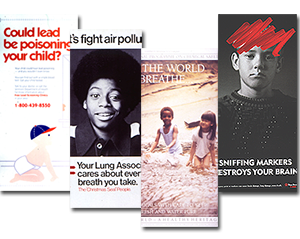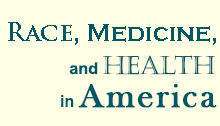Education
Higher Education Module
Race, Medicine, and Health in America
 Scholars have begun thinking more critically about the boundaries of history, particularly the overlap of disciplines and fields long-thought of separately. For example, recent scholarship on the ways in which different ethnic groups engaged with the environmental world in time and space has pushed the boundaries of race and environmental history in important ways. At the same time, scholarship on race and medicine and the environment’s role in the production of health disparities is now well established. This teaching module provides a template for thinking about these historical connections in the classroom.
Scholars have begun thinking more critically about the boundaries of history, particularly the overlap of disciplines and fields long-thought of separately. For example, recent scholarship on the ways in which different ethnic groups engaged with the environmental world in time and space has pushed the boundaries of race and environmental history in important ways. At the same time, scholarship on race and medicine and the environment’s role in the production of health disparities is now well established. This teaching module provides a template for thinking about these historical connections in the classroom.
The Race, Medicine, and Health in America teaching module is divided into three thematic units. The first unit focuses on asthma and lead poisoning; particularly how racism and inequality results in differential exposure to toxic environments, or the inability to control environments. Unit two includes two classes on the origins of the environmental injustice movement. While questions of race and environmentalism date to the late 19th-century, what we now consider the origins of the modern environmental racism movement emerged from the 1978 Love Canal disaster and 1982 Warren County, North Carolina Protests. Both revolve around toxic contaminants dumped into the ground and vulnerable populations that protested such actions. The final unit includes two classes on environmental disasters, health and race. The 1995 Chicago Heat Wave and Hurricane Katrina in 2006 are vastly different environmental disasters. The 1995 heat wave was subtle, lacked the visual destruction of private and public property, and perhaps more than other disasters reified the reasons why minorities and the poor suffer the most from environmental catastrophes. Hurricane Katrina was more visible in its destruction and reflected long-standing vulnerabilities of race and class rooted in medical dependency to life-sustaining technologies.
The three units are divided into six one-hour long classes, each providing an introduction to the material, primary and secondary sources, and discussion questions instructors might use while teaching about the interconnectedness of race, medicine and the environment in the 20th century.
This module is authored by Richard Mizelle, PhD. Information about the author, suggested use, and academic objectives, is also available online at About the Module.
Unit I. Environmental Landscapes
The first unit contains material for thinking about the social and political history of asthma and lead poisoning during the twentieth century.
Class 1: Created Suffering and the Rise of Asthma
Class 2: Lead Poisoning and the Politics of Uncertainty
Unit II. Environmental (In)justice
This unit focuses on the 1978 Love Canal disaster in upstate New York and 1982 Warren County, North Carolina Protests. Although the origins of the modern Environmental (In)justice Movement began well before the 1970s and 1980s with battles over housing and access to public parks and beaches earlier in the century, the Love Canal and Warren County protests are widely considered to have stimulated a broad national movement countering environmental inequity.
Class 3: The 1978 Love Canal Disaster
Class 4: 1982 Warren County, NC Protests
Unit III. Health and Environmental Disasters
The last unit situates two different but similar environmental disasters within memory. Both the 1995 Chicago Heat Wave and Hurricane Katrina in 2005 highlighted a much longer history of environmental neglect and suffering among many. There is no such thing as a purely “natural” disaster. Minorities, the socio-economic poor, and the disenfranchised are often the most vulnerable groups during an environmental disaster. Importantly both disasters reified questions of race and class, as those citizens with resources and mobility were largely able to avoid the worst aspects of trauma.
Class 5: The 1995 Heat Wave
Class 6: Hurricane Katrina


